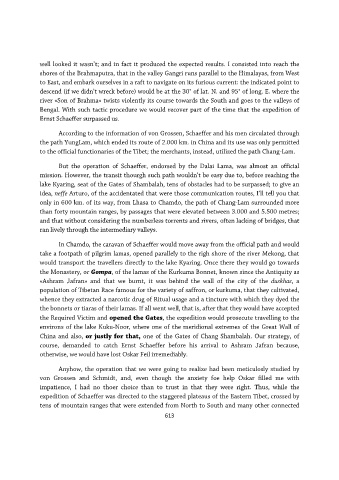Page 613 - Microsoft Word - Belicena respaldo
P. 613
well looked it wasn’t; and in fact it produced the expected results. I consisted into reach the
shores of the Brahmaputra, that in the valley Gangri runs parallel to the Himalayas, from West
to East, and embark ourselves in a raft to navigate on its furious current: the indicated point to
descend (if we didn’t wreck before) would be at the 30° of lat. N. and 95° of long. E. where the
river «Son of Brahma» twists violently its course towards the South and goes to the valleys of
Bengal. With such tactic procedure we would recover part of the time that the expedition of
Ernst Schaeffer surpassed us.
According to the information of von Grossen, Schaeffer and his men circulated through
the path YungLam, which ended its route of 2.000 km. in China and its use was only permitted
to the official functionaries of the Tibet; the merchants, instead, utilized the path Chang-Lam.
But the operation of Schaeffer, endorsed by the Dalai Lama, was almost an official
mission. However, the transit thourgh such path wouldn’t be easy due to, before reaching the
lake Kyaring, seat of the Gates of Shambalah, tens of obstacles had to be surpassed; to give an
idea, neffe Arturo, of the accidentated that were those communication routes, I’ll tell you that
only in 600 km. of its way, from Lhasa to Chamdo, the path of Chang-Lam surrounded more
than forty mountain ranges, by passages that were elevated between 3.000 and 5.500 metres;
and that without considering the numberless torrents and rivers, often lacking of bridges, that
ran lively through the intermediary valleys.
In Chamdo, the caravan of Schaeffer would move away from the official path and would
take a footpath of pilgrim lamas, opened parallely to the righ shore of the river Mekong, that
would transport the travellers directly to the lake Kyaring. Once there they would go towards
the Monastery, or Gompa, of the lamas of the Kurkuma Bonnet, known since the Antiquity as
«Ashram Jafran» and that we burnt, it was behind the wall of the city of the duskhas, a
population of Tibetan Race famous for the variety of saffron, or kurkuma, that they cultivated,
whence they extracted a narcotic drug of Ritual usage and a tincture with which they dyed the
the bonnets or tiaras of their lamas. If all went well, that is, after that they would have accepted
the Required Victim and opened the Gates, the expedition would prosecute travelling to the
environs of the lake Kuku-Noor, where one of the meridional extremes of the Great Wall of
China and also, or justly for that, one of the Gates of Chang Shambalah. Our strategy, of
course, demanded to catch Ernst Schaeffer before his arrival to Ashram Jafran because,
otherwise, we would have lost Oskar Feil irremediably.
Anyhow, the operation that we were going to realize had been meticulosly studied by
von Grossen and Schmidt, and, even though the anxiety foe help Oskar filled me with
impatience, I had no thoer choice than to trust in that they were right. Thus, while the
expedition of Schaeffer was directed to the staggered plateaus of the Eastern Tibet, crossed by
tens of mountain ranges that were extended from North to South and many other connected
613

